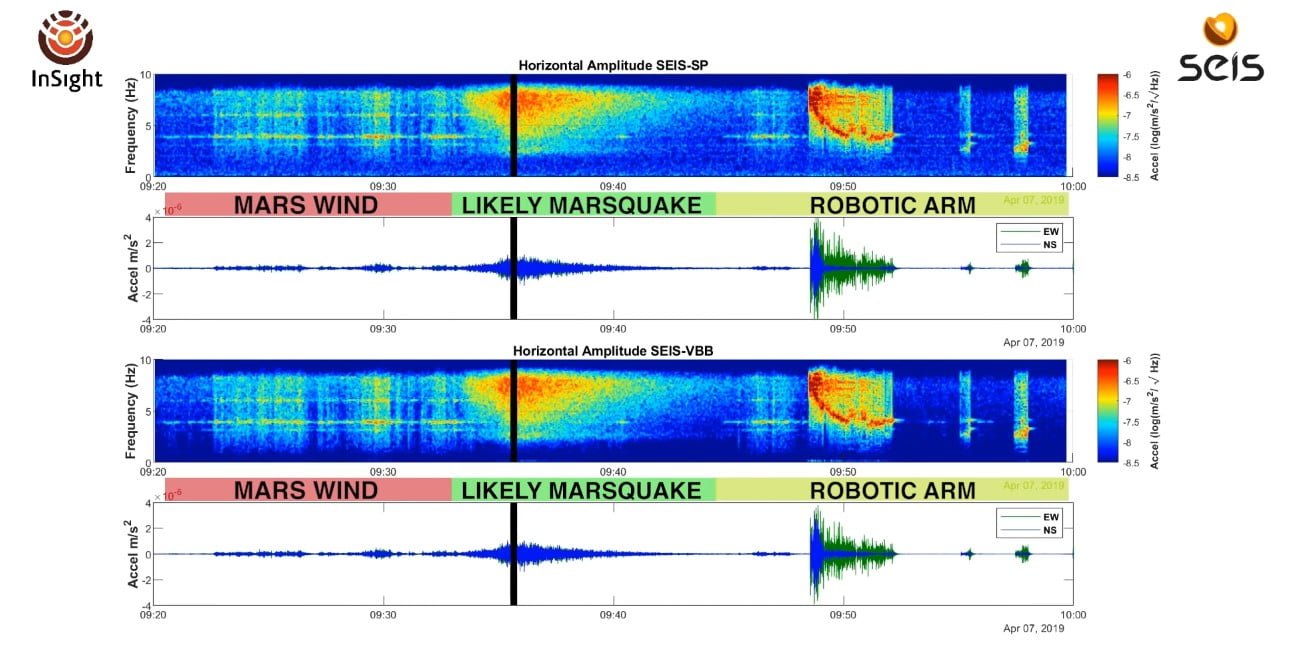NASA’s Mars InSight lander detected a faint seismic signal associated with its first Marsquake. The lander uses the Seismic Experiment for Interior Structure (SEIS) instrument to detect seismic signals on the Red Planet. The signal was detected on April 6, which marks the 128th Martian day or sol for the spacecraft, NASA announced.
Right now, scientists are examining the data to find out what caused the signal to occur and learn more about Marsquakes.
“InSight’s first readings carry on the science that began with NASA’s Apollo missions,” InSight Principal Investigator Bruce Banerdt of NASA’s Jet Propulsion Laboratory (JPL) in Pasadena, California said in a press release. “We’ve been collecting background noise up until now, but this first event officially kicks off a new field: Martian seismology!”
The first Marsquake detected by the lander appears to not be big enough to provide researchers with enough data about the Martian interior. Mars InSight Lander’s purpose is to explore as much as possible about Mars’ interior and seismology, but that appears to be quite a difficult challenge, given that the Martian surface is fairly quiet. Nevertheless, SEIS detects faint rumbles and this minor Marsquake is one of them. NASA wrote that if such a shake occurred in Southern California, it would be lost among all the tiny crackles that take place in a day.
“The Martian Sol 128 event is exciting because its size and longer duration fit the profile of moonquakes detected on the lunar surface during the Apollo missions,” said Lori Glaze, Planetary Science Division director at NASA Headquarters.
InSight has a seismometer which was placed on the surface on Dec. 19, 2018, which could enable scientists to gather similar data about Mars in the way that Apollo astronauts used to learn about the moon.
Researchers also detected three other seismic signals using the Mars InSight lander on March 14 (Sol 105), April 10 (Sol 132) and April 11 (Sol 133), although they were smaller compared to the event that took place on Sol 128.
“We’ve been waiting months for a signal like this,” said Philippe Lognonné, SEIS team lead at the Institut de Physique du Globe de Paris (IPGP) in France. “It’s so exciting to finally have proof that Mars is still seismically active. We’re looking forward to sharing detailed results once we’ve had a chance to analyze them.”
Many people understand how quakes on Earth work. However, unlike Earth, Mars and the Moon don’t have tectonic plates but are able to experience quakes. Scientists attribute the first Marsquake to the process of cooling down and contractions that create stress, building up until it breaks the crust.
Detecting them is nowhere near easy. Using seismometers that are sealed underground and isolated from the elements enable researchers to easily detect seismic changes and signals on Earth. On the other hand, the Mars InSight lander has instruments with insulating barriers which protect the device from temperature changes and wind to detect seismic changes. All in all, SEIS has surpassed the expectations of researchers working on the InSight program, when it comes to its sensitivity to Martian quiet quakes.





